人教版英语必修一第四单元教学设计
必修一英语四单元教学设计
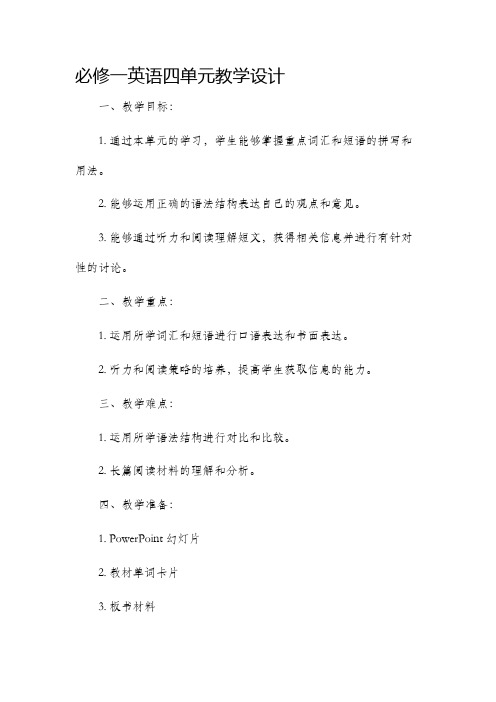
必修一英语四单元教学设计一、教学目标:1. 通过本单元的学习,学生能够掌握重点词汇和短语的拼写和用法。
2. 能够运用正确的语法结构表达自己的观点和意见。
3. 能够通过听力和阅读理解短文,获得相关信息并进行有针对性的讨论。
二、教学重点:1. 运用所学词汇和短语进行口语表达和书面表达。
2. 听力和阅读策略的培养,提高学生获取信息的能力。
三、教学难点:1. 运用所学语法结构进行对比和比较。
2. 长篇阅读材料的理解和分析。
四、教学准备:1. PowerPoint幻灯片2. 教材单词卡片3. 板书材料五、教学过程:Step 1:导入新单词 (10分钟)1. 讲解新单词和短语,并使用图片和实物进行说明。
2. 学生进行跟读练习,并运用所学词汇进行句子造句。
Step 2:听力训练 (15分钟)1. 播放录音,让学生根据听到的内容选择正确的答案。
2. 听完录音后,进行听力答案核对和讲解。
Step 3:阅读训练 (20分钟)1. 学生阅读教材中给出的短文,完成相关的阅读理解题目。
2. 学生之间互相讨论,核对答案,并给出自己的理由和观点。
Step 4:语法讲解和练习 (15分钟)1. 通过示例句子引导学生发现并总结本文所学语法结构的用法。
2. 分组讨论和展示,运用所学语法结构进行口语练习。
Step 5:口语训练 (25分钟)1. 分组讨论一个话题,如“你的理想职业是什么?”,并用所学语法结构进行讨论表达。
2. 分组之间进行互相提问和回答,鼓励学生用所学句型进行交流。
Step 6:总结和巩固 (10分钟)1. 学生进行小结,总结本单元所学的重点知识和语法结构。
2. 教师给予肯定和提醒,巩固学生对所学内容的记忆。
六、课后作业:1. 完成教材中的课后练习题。
2. 写一篇短文,介绍你的理想职业,使用本单元所学的词汇和语法结构。
七、教学反思:本节课设计了多样化的教学活动,从听力、阅读、语法到口语训练,充分利用了多种教学方法。
通过听力和阅读训练,培养学生获取信息的能力;通过语法讲解和口语训练,提高学生运用所学知识进行表达的能力。
Unit4 教学设计 高中英语人教版必修第一册

必修一Unit4 Reading and Thinking【Teaching Objectives:】1.Enable students to understand the causes and consequences of the Tangshan earthquake.2.Develop students' reading comprehension skills, such as skimming, scanning, and inferencing.3.Cultivate empathy and awareness about the impact of natural disasters on communities.4.Encourage critical thinking and discussions about resilience and rebuilding aftera disaster.【Teaching Key and Difficult Points】Key Point: Understanding the timeline and events of the Tangshan earthquake.Identifying the actions taken to rebuild Tangshan and support its inhabitants.Difficult Point: Discussing the emotional and social impact of natural disasters on communities.【Teaching Procedure:】Step1. Warm-upBegin the lesson by asking students if they have ever experienced or heard about any natural disasters in their region or other parts of the world. Encourage them to share their experiences or what they know about these events.Step2. Pre-ReadingAnticipation Guide Prepare an anticipation guide with statements related to earthquakes, disasters, and resilience. Have students respond to the statements before reading the article. Sample statements:"Earthquakes only affect the region where they occur.""Rebuilding after a disaster is an impossible task.""People's unity is essential in overcoming a disaster."After the article is read, revisit the statements to discuss whether their opinions have changed.Step3. While-ReadingActivity 1: Visualizing the SceneDisplay a picture of the Tangshan earthquake aftermath, and ask students to describe what they see. Prompt them to visualize the impact and destruction caused by the earthquake.Activity 2: Comprehension QuestionsDivide the class into groups and provide each group with a set of comprehension questions related to the article. Example questions:What time did the earthquake occur?How many people were estimated to be dead or injured?How did the government and volunteers help Tangshan recover? Encourage students to refer back to the article for answers and discuss their responses within their groups.Activity 3: Cause and EffectHave students identify the causes and effects of the Tangshan earthquake. Discuss as a class how natural disasters can have far-reaching consequences and how communities respond in the aftermath.Step4. Post-ReadingActivity 1: Survivor StoriesAsk students to imagine they were survivors of the Tangshan earthquake. In small groups, they can create short narratives from the perspective of different individuals who experienced the disaster. Encourage creativity and empathy in their storytelling.Activity 2: Disaster PreparednessPoster Divide the class into teams and assign each team a specific natural disaster (e.g., earthquake, flood, hurricane). Have the teams create informative posters that highlight safety tips and preparation measures for that particular disaster.HomeworkAsk students to research and write a short essay on a different natural disaster that occurred in a different part of the world, discussing its impact on the community and how people responded to rebuild and recover.。
高中英语人教必修一第四单元阅读课教学设计
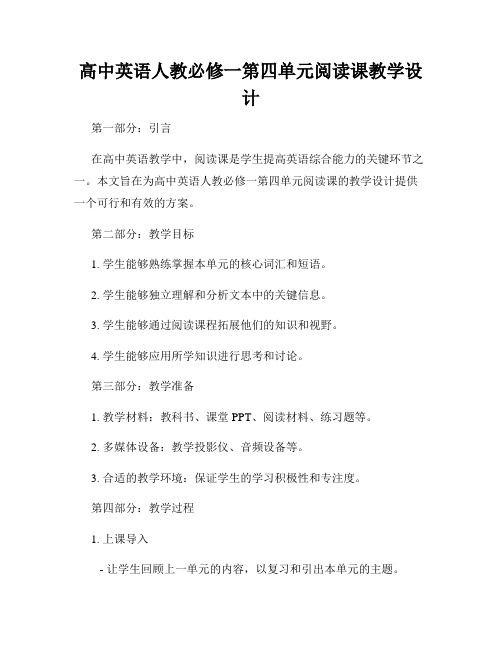
高中英语人教必修一第四单元阅读课教学设计第一部分:引言在高中英语教学中,阅读课是学生提高英语综合能力的关键环节之一。
本文旨在为高中英语人教必修一第四单元阅读课的教学设计提供一个可行和有效的方案。
第二部分:教学目标1. 学生能够熟练掌握本单元的核心词汇和短语。
2. 学生能够独立理解和分析文本中的关键信息。
3. 学生能够通过阅读课程拓展他们的知识和视野。
4. 学生能够应用所学知识进行思考和讨论。
第三部分:教学准备1. 教学材料:教科书、课堂PPT、阅读材料、练习题等。
2. 多媒体设备:教学投影仪、音频设备等。
3. 合适的教学环境:保证学生的学习积极性和专注度。
第四部分:教学过程1. 上课导入- 让学生回顾上一单元的内容,以复习和引出本单元的主题。
- 引入本单元的主题,激发学生的学习兴趣。
2. 预习任务- 学生在课前阅读教科书中的相关阅读材料,了解文章的大意和关键内容。
- 学生可以在教室中小组讨论或写下一到两个问题。
3. 教师示范- 教师用板书或PPT展示关键词汇和短语,并解释其意义和用法。
- 教师带领学生朗读和理解文本中的关键句子和段落。
4. 学生合作活动- 学生以小组形式讨论和分享他们的预习问题,教师引导他们扩展思维和观点。
- 学生可以进行角色扮演或小组演示,以提高他们的口语表达能力。
5. 阅读理解- 学生阅读教科书中的阅读材料,并回答与之相关的问题。
- 教师可进行个别辅导,帮助学生理解和解决阅读中的困惑。
6. 扩展活动- 教师可安排一些扩展活动,如观看相关视频、听取相关音频或阅读相关文章。
- 学生可以进行小组讨论或写下他们的观点和反思。
7. 总结评价- 教师对学生的表现进行评价和总结,鼓励他们的努力和进步。
- 学生可以自评和互评,以促进他们的学习动力和自我反思。
第五部分:作业布置1. 学生可完成课后阅读和练习题,巩固对本单元内容的理解和掌握。
2. 学生可撰写一篇关于本单元主题的小作文,以提高他们的写作能力。
人教版高中英语必修一 unit 4 The Earthquake Reading 教学设计

人教版高中英语必修一unit 4 The Earthquake Reading A night the earth didn’t sleep教学设计Module1 unit 4 The Earthquake Reading A night the earth didn’t sleep一、学情分析本课教学对象是高一新生,英语基础知识和听、说、读、写能力都处于英语中等水平。
所以在阅读课型上仍不太适应高中课本中对长篇文章的整体理解。
因此,通过让学生们积极参与实践、学习和使用英语,调动他们学习英语的兴趣,培养他们的阅读技能是本节课的目标。
地震是世界上常见的自然灾害之一,课本内容接近生活实际,对学生有学习和教育意义,容易激发学生的学习热情,易于展开讨论。
二、教材分析本课是高一必修1第4单元里的第2课时--第一篇阅读课(Reading)。
在第一课Warming Up里面学生已经了解了世界上的一些自然灾害,初步接触和学习了一些与其相关的词语,这一课Reading是上文的延续。
通过本节课的学习,使学生了解地震前的征兆以及地震对人类生活造成的危害,同时介绍了地震后国家和人们对灾区的救援和重建活动。
三、教学目标:本课为阅读型课,主要是通过阅读材料让学生抓住要点获取信息。
具体目标如下:(1)知识技能目标:了解更多关于地震的知识,掌握本文的结构并学习一些课内重点短语和表达的用法。
同时,通过本节课的学习培养学生快速寻找文章细节、归纳和总结的阅读能力。
(2)过程方法目标:运用图片、表格、视频、猜测以及快速阅读、讨论等各种方法,学生能够更好地理解文章内容;同时可以参与课堂群体的活动。
(3)情感价值目标:让学生形成正确对待自然灾害的价值观,提高自我保护和帮助他人的意识(4)教学方法:任务型阅读师生互动(5)教学策略:多媒体课件四、教学重点1. Present a sequence of events to introduce to the students and try to describe an earthquake. Let student pay attention to some useful words and sentences and the way to describe an earthquake.2. Let the students know what the correct attitude towards a disaster is and what we should do in a disaster for ourselves and for the other people.五、教学难点Teach the students how to appreciate an article.Teaching aidsMultimedia六、教学辅助手段PPT,video , pictures七、教学过程Step ⅠPresentation (6 minutes)Ask: What is the passage about? 2. If you were the author, what would you write in the passage?1. Present some pictures to students and guess the natural disaster “EARTHQUAKE”2. Tell students that many earthquakes have happened in the world.(教师通过看图谈论,直观地将与本课内容有关的图片展现出来,快速的导入,学生很自然地被迁移到了新课中来,并体现标题导学的阅读策略)Step Ⅱ reading and comprehension (22 minutes)1. Fast reading:Ask the students to skim the passage and answer questions.Guide the students to find out the topic sentences and analyze the structure of the reading as well as use one word to summarize the main idea of each part(教师利用快速阅读让学生先掌握课文主题,学会利用文章重点词语和主题句帮助自己明白文章总体脉络,使学生对文章有个全面印象。
人教版英语必修一Unit 4教学教案
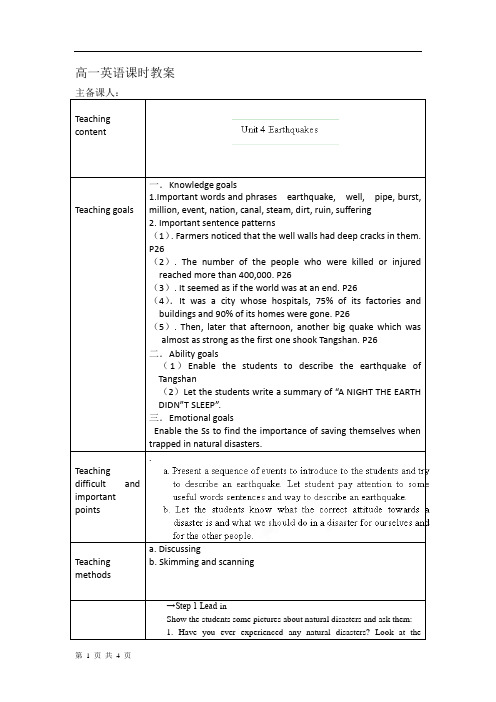
Wells:
Animals:
Lights and sound:
Water pipes:
People of the city thought______________ and______________
While the earthquake:
At 3:42 am
→Step 7 Homework
1. Learn the new words and expressions in this part by heart.
2. Read the text again and again and write a summary of the text.
Exercise1 Questions:
D、dams and wells were useless.
E、they didn’t know what the strange events meant.
Exercise2
Time
What happened
Result
Before the earthquake:
three days before the earthquake
一、Join the correct parts of the sentences.
1 The chickens didn’t eat because
2 The people didn’t worry because
3 Such a great number of people died because
4 Water was needed because
5 The people did not lose hope because
人教版英语必修一第四单元教学设计

Discussion Homework
学习必备
欢迎下载
2.2 教学过程展示
教学步骤 多元导入
教师活动
学生活动
设计目的
1、播放电影 《唐山大地震》 片段并提问。 Q: Which city do you know ? Where does the city of Tangshan lie? Have you ever seen it before?
完成作业。
2、了解旧金山。收集旧金山的资料(如 人文、地理、历史概况、旅游资料等) , 并向大家解说。 (供优等生选做)
1 、培养学生的语言表 达能力及合作能力。 2 培养学生的自我总结 能力。
1、提高学生的动手能 力及同学之间的合作 能力。
2 、提高语言输出能力 及收集资料的能力, 给 各层次学生一次展示 自己的机会。
实践探索
1、展示唐山的图片。让学生回答以下问 题:
1.让学生简单描述有 关 1、培养学生的听、说
于唐山大地震的感受。
能力。
Q: Have you ever heard of the earthquake 2.让学生在听歌曲中 缓 2、培养学生解由看完电影 《唐山大地 及锻炼他们的口语能
1. Imagine your home begins to shake and you must leave it right away. You have time to take only one thing. What will you take? Why?
2. What do you think will happen before an earthquake?
3、教学反思:
备注:板书设计
学习必备
Unit4NaturalDisastersReadingandthinking教学设计-高中英语人教

人教版高一英语必修一Unit4 NA TURAL DISASTERS Reading and Thinking教学设计教材分析1.单元背景。
本单元以“自然灾害”为话题,包含了地震、火山喷发、海啸、飓风等自然灾害的介绍,以及如何在灾难中自救和救人的方法。
在自然灾害面前,人类有时显得很渺小,但是了解自然灾害,掌握自救和救人的方法,却能使我们有效地减少灾害带来的损失。
2.单元分析及教材处理。
为了让学生有充足的Natural Disasters 知识和正确的情感态度去面对自然灾害,而且学生也能学有所用。
本单元旨在让学生了解自然灾害的种类、发生的原因、危害以及如何自救和救人。
让学生对Natural Disasters 的知识有一定的了解,并明白各种自然灾害的破坏性。
使学生在认识的基础上进一步学习阅读课文里有关灾难——地震来临前的征兆和地震过程中的相关知识,并懂得在地震中如何自救,如何救人等内容。
在学习知识的同时增强了学生的社会责任感,树立了正确的人生观,价值观。
珍爱生命,在大灾难前要有大爱,这样也提高了学生的自身素养I.Teaching Content:Unit4 Earthquakes ReadingA Night the Earth Didn’t Sleep II.Teaching time:45 minutesIII.Teaching Goals1. Knowledge aim1). Get the students to learn some useful words and expressions.2). Develop the students reading ability and let them learn different reading skills.2. Ability aims:1). Get the students know damages earthquake bring about and the ways to reduce losses of earthquake.2). Get the students to know how to protect oneself and help others in earthquake.3. Moral aims:1). Know what damages an earthquake will bring about and the ways to reduce losses of an earthquake.2). Know how to protect oneself and to help others in an earthquake.IV. Important points:1.Words: shake, rise, crack, burst, well, smelly, pond, steam, destroy, ruin, injure, survivor, brick, useless, shock, quake, rescue, electricity, disaster, organize, bury, coal, mine, shelter, fresh, percent.2.Phrases: right away, at an end, lie in ruins, be trapped under sth, put up, give out, wake sb up, prepare sth for sth., think little of sth.3.Sentences:(1). It seemed as if the world was at an end.(2). Onethird of the nation felt it.(3). In fifteen terrible seconds, a large city lay in ruins.V. Difficult points1. The meanings of some words and expressions.2. Describe a natural disaster, such as an earthquake3. Understanding of sentences which contain Attributive Clause.VI. Teaching tools blackboard, courseware, tape recorder and some coloured ,pictures.VII. Teaching MethodsSituational teaching methods & interactive teaching methods, cooperative exploring methods.VIII. Teaching Procedures1.Greetings2. LeadinTeacher shows some pictures about the earthquake. Students look at the pictures and think of some new words relating to the natural disasters.3.Reading1). Fast readingTeacher shows the title and the photo on page fifty. Let students guess what the text is about. Student will be given five minutes to get the main idea and pay attention to the beginning and any sentences in each paragraph and find out the topic sentence and then match the main idea with each paragraph.Para.1: A.The rescue work.Para.2: B.The revival of the city.Para.3: C.Warning signs before the earthquake.Para.4: D.The happening of the big earthquake.Para.5: E.The immediate effects of the earthquake2). CarefulreadingStudents will be given five minutes to read part one carefully and do the following exercises: What were some of the strange things happening before the earthquake and how did people in react to the signs.How did people in Tangshan react to the signs?A.Ignorant. B.Alert. C.Sensitive. D. Casual3. What rhetorical device(修辞手法) does the author use in the sentence “the water in the village wells rose and fell, rose and fell”?A.Metaphor(比喻).B.Repetition(重复).C.Parallelism(排比).D.Personification(拟人).参考答案A AFunction: To make the description more vivid and involve the readers in the atmosphere.Students read part 2 carefully and do the following exercise and read paragraph 3 to carefully to do the following exercise the teacher will choose some students to show your answers for others1. How can we protect ourselves in an earthquake at school?2.What can you do after an earthquake?(Creative thinking)PostreadingGroupwork(1) Don’t be nervous and keep calm.(2) Don’t try to run out of the classroom.(3) Sit down under your desk.(4) Protect your head by putting your bag on your head.(5) Don’t use lift.(6)If possible,run to the schoolyard.IX. Group workStudents will be given five minutes to have a group of work to have a discussion about how can we protect ourselves in an earthquake at school and what can you do after an earthquake? Whatdo you think helped in the revival of city?What lesson can we learn from these events? Some students will be invited to share their answers for the other students.The spirit of bating disaster relief抗震救灾精神Whether in Tangshan earthquake or in Wenchuan earthquake, the most important thing is the spirit of Chinese people. Every time a disaster happens, we fight against it together and we never lose hope. That is the spirit of bating disaster reliefRecently, in the battle against COVID19, China did the best in controlling the virus. That is the result of the spirit of bating COVID19X. SummarySome students will be invited to have a summary about what did we learn today.XI. Homework1.Write a passage about your feelings after today’s passage learning.2.Finish activity 5.XII. Blackboard writingXIII. Teaching reflection课后反思依据教学目标,对学生的学习过程进行评价,旨在反思教学效果,不断改进自己的教学方法与策略。
Unit 4 Natural Disasters教学设计-高中英语人教版(2019)必修第一册
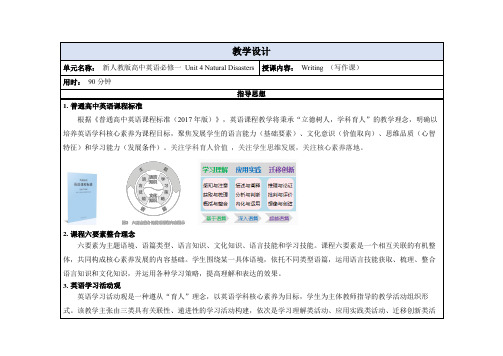
指导思想1.普通高中英语课程标准根据《普通高中英语课程标准(2017年版)》,英语课程教学将秉承“立德树人,学科育人”的教学理念,明确以培养英语学科核心素养为课程目标,聚焦发展学生的语言能力(基础要素)、文化意识(价值取向)、思维品质(心智特征)和学习能力(发展条件)。
关注学科育人价值,关注学生思维发展,关注核心素养落地。
2.课程六要素整合理念六要素为主题语境、语篇类型、语言知识、文化知识、语言技能和学习技能。
课程六要素是一个相互关联的有机整体,共同构成核心素养发展的内容基础。
学生围绕某一具体语境,依托不同类型语篇,运用语言技能获取、梳理、整合语言知识和文化知识,并运用各种学习策略,提高理解和表达的效果。
3.英语学习活动观英语学习活动观是一种遵从“育人”理念,以英语学科核心素养为目标,学生为主体教师指导的教学活动组织形式。
该教学主张由三类具有关联性、递进性的学习活动构建,依次是学习理解类活动、应用实践类活动、迁移创新类活Step 3: First reading (8 mins):news Tsunami Hits Asia: Over 6,500 Dead, T asks Ss to make a judgement of a sample summary and then write a summary of their own version.Here is one summary of the news report.Read and check the main points it includes. Then write your own version.Writing1)Firstly, ss read the text and write a list of main elements(details), filling the first column of the table. T then give the suggested answers.P1: Strange things happened in the countryside before the earthquake.P2: An earthquake hit Tangshan, China on 28 July 1976.P3: More than 400,000 people were killed or badly injured.P4: Nearly everything in the city was destroyed.P5: The government and soldiers came and began rescuing and rebuilding the city.2)After that, ss write down the main idea of each paragraph based on the elements(details) in the first column, filling the second column of the table.Step 7: Drafting (15 mins)Step 9: Revising (5 mins)Ss get back their draft back and revise it according to the feedback they get from their partners. Students are encouraged to put forward questions on what they are not understand.Homework。
人教版高中英语必修一Unit4整体教案

Teaching plan for unit 4Teaching aims and demands:1. Topic:Basic knowledge of earthquakes; how to protect oneself and help the others in disasters2. Useful words and expressions:earthquake, quake, right away, well (n.) , million , event , pipe, burst, as if, at an end , nation , canal, steam, dirt, ruin, in ruins , suffering, extreme, injure, destroy, brick, dam, track, useless, steel, shock, rescue, trap, electricity, disaster, dig out, bury, mine, miner, shelter, a (great ) number of , title, reporter, bar, damage, frighten, frightened, frightening, congratulation, judge, sincerely, express, outline, headline, cyclist3. Functions:Talking about past experiences:I will never forget the day when the earthquake took place. The time was 5:15 in the afternoon and I was driving along the road.Sequence4. Grammar:The attributive clause (I)由that, which, who, whose引导的定语从句The number of people who were killed or injured reached more than 400,000.It was heard in Beijing which is one hundred kilometers away.Workers built shelters for survivors whose homes had been destroyed.Teaching procedures:Period 1.Step 1. Warming upSs discuss and answer some questions:1. Which of the following may cause people the greatest damage?A. earthquakeB. typhoonC. floodD. drought2.Imagine your home begins to shake and you must leave it right away. You have time to take only one thing. What will you take? Why?Step 2. Pre-readingSs discuss and answer:1.Do you know what would happen before an earthquake?2.What can we do to keep ourselves safe from an earthquake?3. Do you know anything about Tangshan Earthquake in 1976?Step 3. Reading1.Skimming and find the answers to the following questions:a.What happened?b.When and where did it happen?3.Ss read the whole passage again and get the main ideas of each part:Part 1. The natural signs of a coming earthquakePart 2-3. The damage of the city after the earthquakePart 4. The help to the survivorsStep 4. ComprehendingSs finish Ex 1 and 2 on page 27.Step 5. Assignment1.Surf the internet and get more information about the earthquake.2.Retell the text.Period 2.Step 1. Warming up1.Ss share more information about the earthquake.2.Ask some Ss to retell the text by using their own words.Step 2. Language points1.lie –lay-lain (v.) : to be, remain or be kept in a certain state 处于某种状态The village lay in ruins after the war.These machines have lain idle since the factory closed.2.in ruins: severely damaged or destroyed 毁坏an earthquake left the whole town in ruins.His career is in ruins.3.number (n.): a quantity of people or things 数目;数量The number of people applying has increased this year.We were fifteen in number.a number of: a lot ofI have a number of letters to write.A large number of people have applied.4. injure (v.): to hurt oneself/sb./ sth. physically 受伤He fell off the bicycle and injured his arm.5. reach (v.): to achieve or obtain sth. 达成;达到;获得You’ll understand it when you reach my age.At last we reached a decision.6. rescue (n.): an act of rescuing or being rescued 搭救;解救A rescue team is trying to reach the trapped mines.Rescue (v.): to save or set free from harm, in danger, or loss 解救;救出The rescued the man from drowning.7. trap(v.): in a place from which one wants to escape but cannot 困住;陷于绝境They were trapped in the burning hotel.8. all …not… = not all…: some but not all 一些;但不是全部Not all the girls left.=Only some of them left early.Not all the children are noisy.=Some of the children are not noisy.全部否定应用: none of…None of us were allowed to go there.None of these reports is very helpful.Step 3. learning about language1. Ss finish Ex 1,2 and 3 on page 27 and 28.2. Teacher checks the answer and give the Ss some help if they have some difficulty. Step 4. assignment1.Finish Wb.Ex.1 on page 63.2.Ss try to remember the useful words and expressions by hearts.Period 3Step 1. Warming upSs read the passage again and try to find the sentences with attributive clauses.e.g. Workers built shelters for survivors whose homes had been destroyed.Step 2. Attributive clause1.Give Ss more sentences and let the Ss to find the structures of the attributiveclause.2.Ss do some exercises about how to use that, which, who or whose.3.Ss finish Ex 2 on page 28.Some materials about attributive clause:关系代词引导的定语从句关系代词所代替的先行词是人或物的名词或代词,并在句中充当主语、宾语、定语等成分。
高中英语 Unit4 The Story of an Eyewitness教学设计 新人教版必修1

教学环节
教师活动
预设学生行为
设计意图
Step1: Lead-in
Step 2 Warming up
Step 3Reading
Step 4 Activity
1.Before class, show the MV of Heal the World by Michael Jackson and make students aware of today’s topic while enjoying music.
☆学生学习活动评价设计
1. 课堂上学生讨论及发言的积极性
2. 给学生提供图片,利用本节课所学单词及短语造句,查看学生使用词汇的熟练程度。
☆教学反思
Bothadvantages and disadvantages exist in the teaching activity throughout the whole class.
☆教学目标
1.Knowledge objectives
The students should be able to get a general idea ofthe greatSan Franciscoearthquake.
2.Ability objective
The studentsshould be able to
As regard to the advantages of the teaching activity, the most important and eye-catching one is the application of multimedia in the forms of pictures and video clip, which leaves vivid and unforgettable impression on the students. For example, at the verybeginningof the class, the teacher showed a group of pictures about the natural disasters and the ruins of the great disaster of earthquake. After that, a video clip about the greatearthquakenot only brings about shocking and unbelievable feelings to the students but also let them know thebackgroundof the greatearthquake. This is an interesting and effective way to make students quickly concentrate on the lesson and activate their imagination. Besides, the method of task-based teaching is usedthroughoutthe whole class to stimulate students’initiativein learning and develop their ability in language application.Each step is always followed by some tasks for students to finish.The most innovative part of the lesson,Ithink, is language appreciation activity.Iattempt to impress students the purpose of using rhetorical device in an article.It seems difficult for a teacher to make middle school students aware of rhetorical devices in an English article.Iapply the teaching and learning method of paraphrasing,corporative-work to appreciating the language.
必修一英语第四单元教案
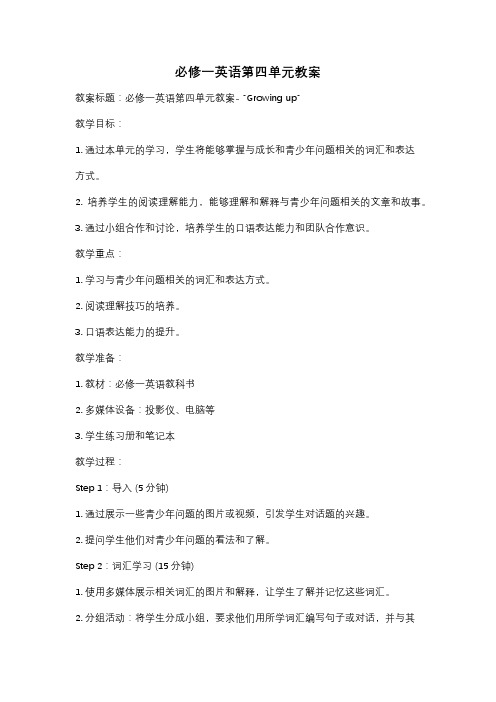
必修一英语第四单元教案教案标题:必修一英语第四单元教案- "Growing up"教学目标:1. 通过本单元的学习,学生将能够掌握与成长和青少年问题相关的词汇和表达方式。
2. 培养学生的阅读理解能力,能够理解和解释与青少年问题相关的文章和故事。
3. 通过小组合作和讨论,培养学生的口语表达能力和团队合作意识。
教学重点:1. 学习与青少年问题相关的词汇和表达方式。
2. 阅读理解技巧的培养。
3. 口语表达能力的提升。
教学准备:1. 教材:必修一英语教科书2. 多媒体设备:投影仪、电脑等3. 学生练习册和笔记本教学过程:Step 1:导入 (5分钟)1. 通过展示一些青少年问题的图片或视频,引发学生对话题的兴趣。
2. 提问学生他们对青少年问题的看法和了解。
Step 2:词汇学习 (15分钟)1. 使用多媒体展示相关词汇的图片和解释,让学生了解并记忆这些词汇。
2. 分组活动:将学生分成小组,要求他们用所学词汇编写句子或对话,并与其他小组分享。
Step 3:阅读理解 (20分钟)1. 学生阅读教科书第四单元的相关文章,理解文章的主要内容和细节。
2. 学生回答教材中的问题,检查他们对文章的理解程度。
3. 分组讨论:将学生分成小组,要求他们讨论文章中提到的问题,并分享他们的观点和解决方法。
Step 4:口语表达 (15分钟)1. 学生分组进行角色扮演,模拟青少年问题的场景,如与父母争吵、面对学业压力等。
2. 鼓励学生使用所学词汇和表达方式,实践口语表达能力。
Step 5:巩固练习 (15分钟)1. 学生完成学生练习册中与本单元相关的练习题。
2. 教师检查学生的练习,并提供及时的反馈和指导。
Step 6:作业布置 (5分钟)1. 布置作业:要求学生写一篇关于青少年问题的短文,并在下节课上交。
教学反思:本节课通过多种教学方法和活动,旨在培养学生对青少年问题的认识和理解,并提高他们的阅读理解和口语表达能力。
人教版高一英语必修一第四单元教学目标

人教版高一英语必修一第四单元教学目标
人教版高一英语必修一第四单元的单元标题是“Wildlife Protection”,主题是“野生动物保护”。
以下是本单元的教学目标:
1. 知识目标:学生能够掌握和理解本单元所学的词汇、短语和句型,包括各种野生动物名称、保护措施、生态平衡等方面的表达。
2. 能力目标:学生能够运用所学知识,就野生动物保护的话题进行简单的口头和书面表达,能够进行简单的阅读和写作练习,提高语言运用能力。
3. 情感态度和价值观目标:通过本单元的学习,增强学生保护野生动物的意识,培养热爱大自然、尊重生命的观念,提高环保意识。
本单元的教学重点和难点如下:
重点:掌握野生动物名称、保护措施、生态平衡等方面的词汇和表达方式。
难点:理解和运用所学知识进行口头和书面表达,提高语言运用能力。
为了实现这些教学目标,建议教师在教学过程中采取以下措施:
1. 创设情境:利用图片、视频等多媒体手段,展示野生动物的生活环境和面临的威胁,引导学生进入情境,增强情感体验。
2. 小组合作:组织学生进行小组讨论,分享彼此对野生动物保护的认识和想法,提高合作意识和沟通能力。
3. 案例分析:选取一些野生动物保护的案例,让学生分析其中的问题和解决方案,培养批判性思维和解决问题的能力。
4. 拓展阅读:推荐一些关于野生动物保护的英文文章或网站,引导学生进行拓展阅读,提高阅读能力和文化素养。
5. 作业与评价:布置与本单元主题相关的作业,如写一篇关于野生动物保护的短文或制作一份宣传海报等,通过多种方式进行评价和反馈,帮助学生发现不足并改进。
人教版英语必修一unit 4教学设计
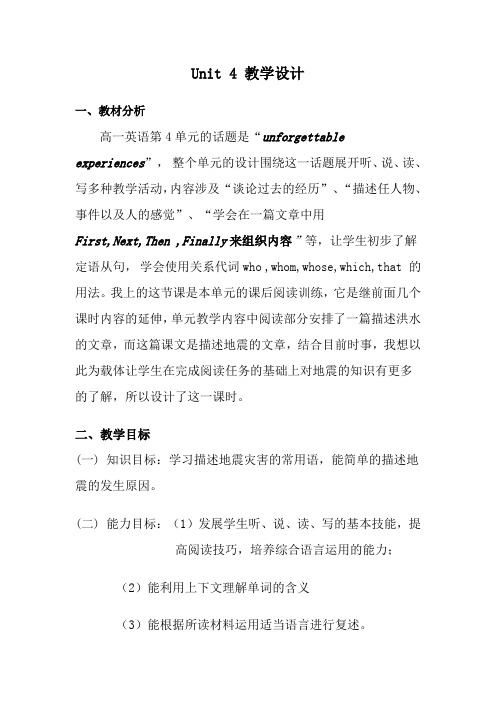
Unit 4 教学设计一、教材分析高一英语第4单元的话题是“unforgettable experiences”,整个单元的设计围绕这一话题展开听、说、读、写多种教学活动,内容涉及“谈论过去的经历”、“描述任人物、事件以及人的感觉”、“学会在一篇文章中用First,Next,Then ,Finally来组织内容”等,让学生初步了解定语从句,学会使用关系代词who ,whom,whose,which,that 的用法。
我上的这节课是本单元的课后阅读训练,它是继前面几个课时内容的延伸,单元教学内容中阅读部分安排了一篇描述洪水的文章,而这篇课文是描述地震的文章,结合目前时事,我想以此为载体让学生在完成阅读任务的基础上对地震的知识有更多的了解,所以设计了这一课时。
二、教学目标(一) 知识目标:学习描述地震灾害的常用语,能简单的描述地震的发生原因。
(二) 能力目标:(1)发展学生听、说、读、写的基本技能,提高阅读技巧,培养综合语言运用的能力;(2)能利用上下文理解单词的含义(3)能根据所读材料运用适当语言进行复述。
(三) 德育目标:通过本文的阅读让学生对地震有更多认识,加强自我保护。
确立教学目标的依据:通过听、说、读、写四项基本语言技能的训练,使学生形成综合语言运用能力,激发学生的学习兴趣,为真实语言交际打基础。
此外,每一门课程都应该尽可能结合学科特点,把培养学生的情感融化到日常教育教学中。
(四) 重点与难点:(1)重点:1.利用不同的任务训练skimming, scanning, careful reading等阅读微技能;2.对地震知识的更多了解。
(2)难点:阅读技能的训练。
三、教学流程:教师将学生分为7组,每组6名同学,并制定小组长及其成员的共同任务和个别任务(或讲演或板书或是评分)。
1、创设情境,新课导入,明确任务(5分钟)由教师朗读一段有关灾害的听力材料,让学生回答时间地点事件。
然后,教师继续:在日常生活中我们可能会遇到各种各样的自然灾害,询问学生知道的灾害,展示图片让学生对此有所了解,然后展示一幅完美的城市图和灾后城市图进行比较,猜测发生变化的原因,从而引出课题,这样通过师生互动,激活主题,激发了学生的学习兴趣,对后面进行本文的阅读做了铺垫和准备。
英语人教版高中必修一(新课标)教案Unit 4 Reading and Thinking 教案
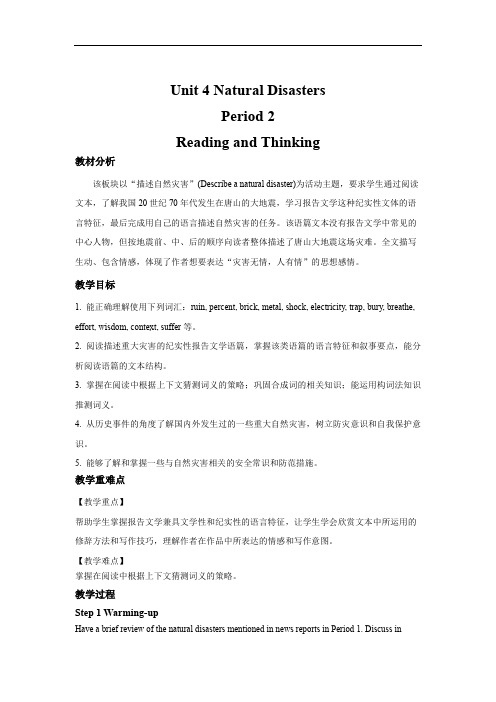
Unit 4 Natural DisastersPeriod 2Reading and Thinking教材分析该板块以“描述自然灾害”(Describe a natural disaster)为活动主题,要求学生通过阅读文本,了解我国20世纪70年代发生在唐山的大地震,学习报告文学这种纪实性文体的语言特征,最后完成用自己的语言描述自然灾害的任务。
该语篇文本没有报告文学中常见的中心人物,但按地震前、中、后的顺序向读者整体描述了唐山大地震这场灾难。
全文描写生动、包含情感,体现了作者想要表达“灾害无情,人有情”的思想感情。
教学目标1. 能正确理解使用下列词汇:ruin, percent, brick, metal, shock, electricity, trap, bury, breathe, effort, wisdom, context, suffer等。
2. 阅读描述重大灾害的纪实性报告文学语篇,掌握该类语篇的语言特征和叙事要点,能分析阅读语篇的文本结构。
3. 掌握在阅读中根据上下文猜测词义的策略;巩固合成词的相关知识;能运用构词法知识推测词义。
4. 从历史事件的角度了解国内外发生过的一些重大自然灾害,树立防灾意识和自我保护意识。
5. 能够了解和掌握一些与自然灾害相关的安全常识和防范措施。
教学重难点【教学重点】帮助学生掌握报告文学兼具文学性和纪实性的语言特征,让学生学会欣赏文本中所运用的修辞方法和写作技巧,理解作者在作品中所表达的情感和写作意图。
【教学难点】掌握在阅读中根据上下文猜测词义的策略。
教学过程Step 1 Warming-upHave a brief review of the natural disasters mentioned in news reports in Period 1. Discuss ingroups what can happen to a city during a big earthquake.设计意图:回顾上节课的内容,激活关于自然灾害和地震的背景知识。
高中英语人教版必修一教案Unit 4 Earthquakes
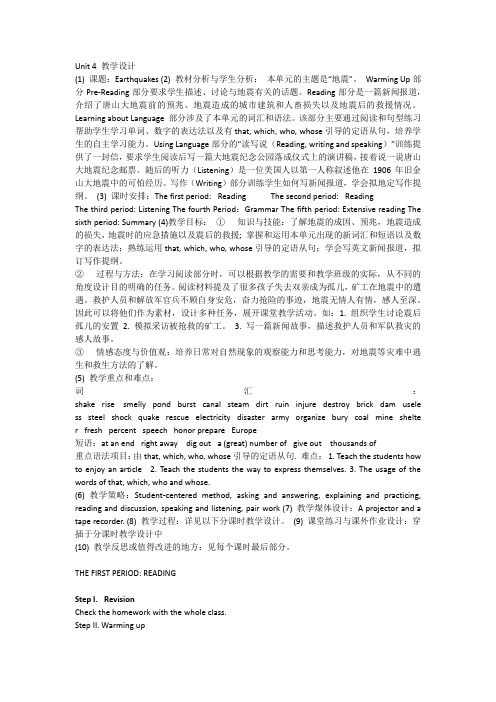
Unit 4 教学设计(1) 课题:Earthquakes (2) 教材分析与学生分析:本单元的主题是“地震”。
Warming Up部分Pre-Reading部分要求学生描述、讨论与地震有关的话题。
Reading部分是一篇新闻报道,介绍了唐山大地震前的预兆、地震造成的城市建筑和人畜损失以及地震后的救援情况。
Learning about Language 部分涉及了本单元的词汇和语法。
该部分主要通过阅读和句型练习帮助学生学习单词、数字的表达法以及有that, which, who, whose引导的定语从句,培养学生的自主学习能力。
Using Language部分的“读写说(Reading, writing and speaking)”训练提供了一封信,要求学生阅读后写一篇大地震纪念公园落成仪式上的演讲稿,接着说一说唐山大地震纪念邮票。
随后的听力(Listening)是一位美国人以第一人称叙述他在1906年旧金山大地震中的可怕经历。
写作(Writing)部分训练学生如何写新闻报道,学会拟地定写作提纲。
(3) 课时安排:The first period: Reading The second period: ReadingThe third period: Listening The fourth Period:Grammar The fifth period: Extensive reading The sixth period: Summary (4)教学目标:①知识与技能:了解地震的成因、预兆,地震造成的损失,地震时的应急措施以及震后的救援; 掌握和运用本单元出现的新词汇和短语以及数字的表达法;熟练运用that, which, who, whose引导的定语从句;学会写英文新闻报道,拟订写作提纲。
②过程与方法:在学习阅读部分时,可以根据教学的需要和教学班级的实际,从不同的角度设计目的明确的任务。
人教高一英语必修一 UNIT-4-reading-and-writing教学设计

Name Subject 英语Time Class TeachingtopicModule 1 Unit 4 Earthquake Using Language Reading and writingTeaching Aims I. Language and ability goal1. To make Ss master the new expressions about gratitude2. To make Ss realize the structure of a thank-you letter.II. Skill goals1. To train Ss’reading skills of understanding the meaning of some specific sentences as well as finding the detailed information2. To practice Ss’ summarizing skills based on the reading exercises3. To develop Ss’ speak ing ability and learn to express their own opinions4. To improve Ss’ writing ability based on all the language inputIII. Emotion, attitude and value goals1. To encourage Ss to be active in class and learn to cooperate with each other in group study2. To improve Ss’ ability to solve problems and to express their own opinions3. To strengthen Ss’ awareness of being grateful to others in lifeTeaching key points 1. Improve Ss’ learning English abilities, including reading, speaking and writing2. Strengthen Ss’ abilities to use the language to express their gratitude3. Lead the Ss to write a thank-you letter by using the expressions learned in the classTeaching difficult points 1. How to help Ss to master reading, speaking and writing skills2. How to guide Ss to write a thank-you letterTeachingaidsBlackboard, PPT and computerTeaching procedures TeachingStepsActivities AimsLead-in I. Zhang Sha phones Li Hua and ask him to check theEmail.II. Have Ss to read the Email.III. Thinking:Why did Zhang Sha write to Li Hua?1. Stimulate Ss’ interestand catch theirattention;2. Encourage Ss to readEnglish aloud3. Practice Ss’ability offast reading. Reading I. Reading comprehensionTask 1: Listening while readingHave Ss listen to the speech given by Li Hua.Task 2: Fast readingWhen did the earthquake happen?Was it a serious one? How do you know?Task 3: Detailed readingWhy did Li Hua say “All hope was not lost”?What did the soldiers do to help the Tangshanpeople?Who do you think made the largest contributions to1.Lead Ss tounderstand howserious the Tangshanearthquake was.2.Have Ss understandwho helped Tangshanpeople a lot.3.Motivate Ss tothe city of Tangshan?Task 4: Detailed readingHow did Li Hua express his gratitude in the speech? ➢______________ are strong enough to express our ________________________________.➢I do wish to _________________________ the people who have made great efforts to this earthquake rescue and city rebuilding..➢____ your love and help ____ made us stronger to come out from the sadness and overcome all the difficulties.➢Thank you ___ your coming/ listening/ consideration.II. Study and presentationTask 1: Study the thank-you letters in groups in two aspects: structure and expressions.Task 2: Have Ss to do the presentation about the result.What can you learn from the letters?Structure:____________________________________________________________________________Expression__________________________________________________________________________________________________________________ III.PracticeFill in the blanksDear Mr. Li,I’m writing to ________________(表达我对你的感激之情). I am now a freshman of Wuhan University, which I have dreamed about. Mr. Li, _________________ (我可以清楚地记得)the days when you taught me English. _________ (由于) your love and help my English have been improved greatly. However, ___________________ (曾经一度)the pressure of examinations, too much homework and the high expectations made me depressed. _______________ _____________(没有你的鼓励和帮助), I wouldn’t have a chance to go to university. I wish more and more of your students could achieve their dreams.__________________(再次表示真挚感谢)!Yours,Li Huaexpress gratitude tothe soldiers and theworkers and learn theexpression from thetext4. Practice Ss’ ability offind and study thetarget expressionswith clear purpose5. Encourage Ss to learnfrom reading andstudy in group work.Practice Ss’ ability ofsummarizing..6. Assess the learningoutcomesSpeaking I.QuestionsWho do you want to thank most in your life? Why?II. Invite some students to share their opinions 1. Encourage Ss to beactive in class2. Improve Ss’ ability toexpress their ownopinions;Writing I. Before writingMake a choice of the taskII. While writingIII. After writingPresent some students’ writingsEmphasize the expressions and the structureIV. Share the possible versions 1.Arouse Ss’ interest infinishing the writingtask2.Improve Ss’writing byadmiring others’ work3. Help Ss to appreciate what a good writing is.Summary I. What have we learned today?➢Expressions about thanks➢Structure about a thank-you letter➢Reading helps us with writing.II. Share the affection goals today.➢Courage to express oneself, especially one’sgratitude. Guide Ss to reflect on the class today.。
- 1、下载文档前请自行甄别文档内容的完整性,平台不提供额外的编辑、内容补充、找答案等附加服务。
- 2、"仅部分预览"的文档,不可在线预览部分如存在完整性等问题,可反馈申请退款(可完整预览的文档不适用该条件!)。
- 3、如文档侵犯您的权益,请联系客服反馈,我们会尽快为您处理(人工客服工作时间:9:00-18:30)。
4、对语言进行加工,内化,提高学生的语言输出能力。
小组分享
1、给出问题让学生在小组内外展示自己的答案并单独抽出几名学生上讲台呈现自己的答案。
Q: Imagine your home begins to shake and you must leave it right away. You have time to take only one thing. What will you take? Why?
学习策略
能通过谈论过去的经历或描述过去发生的事,进一步了解有关的时态的运用。
教学重点
让学生看唐山和旧金山两幅图并能互相讨论过去发生的事,能了解地震发生前的前兆。
教学难点
讲解shake, right away, well等有关词语来帮助学生用英语来描述过去发生的事及地震前的征兆。
教学方法
任务型教学法,多媒体教学,归纳教学,讨论教学
实践探索
1、展示唐山的图片。让学生回答以下问题:
Q: Have you ever heard of earthquake in Tangshan?
Do you know when the earthquake happened?
What happened to the city after the earthquake?
Where does the city of Tangshan lie?
Have you ever seen it before?
预设:播放电影《唐山大地震》歌曲《旧金山》再提问,同学们会展开联想。电影的播放,更能将同学们的兴趣带入一个特别想表达的境地。利用该电影片段进入本堂课的主题。
把同学们的想象力给调动起来,使之尽快融入本模块的主题。问题的提出,使同学们的表达欲望得到释放,课堂气氛也随之活跃起来。
2.让学生在听歌曲中缓解由看完电影《唐山大地震》后带来的凝重感,并展开想象地震后带来的危害。
3.做好笔记,将相关单词串烧记忆。
4.分小组展开讨论,选出最具代表性的一个作品展示。通过观察图片和观看电影,了解到地震发生前的前兆,从而了解地震的有关知识。
1、培养学生的听、说能力。
2、培养学生的想象力及锻炼他们的口语能力。
2、了解旧金山。收集旧金山的资料(如人文、地理、历史概况、旅游资料等),并向大家解说。(供优等生选做)
完成作业。
1、提高学生的动手能力及同学之间的合作能力。
2、提高语言输出能力及收集资料的能力,给各层次学生一次展示自己的机会。
3、教学反思:
备注:板书设计
教学准备
剪辑歌曲《旧金山》,电影《唐山大地震》片段。寻找有关于唐山大地震及旧金山地震前后的照片,制作PPT
2、教学过程
2.1、教学流程图
DDDDdDDD
2.2教学过程展示
教学步骤
教师活动
学生活动
设计目的
多元导入
1、播放电影《唐山大地震》片段并提问。
Q: Which city do you know ?
教学目标
语言知识
掌握well,shake,right away等词汇的用法,回顾有关过去的时态,如:一般过去时,过去进行时,过去完成时。
语言技能
能谈论过去的经历或描述过去发生的事及听懂别人的描述
情感态度
能形成热爱生命,帮助他人的意识。
文化意识
了解地震的有关知识,学习在地震或突遇的灾难中如何自救、救人。
2、引导学生归纳Signs before an earthquake.
1、学生之间互相讨论交流并形成自己的答案。
2、学生自己归纳并做笔记记下来。
1、培养学生的语言表达能力及合作能力。
2培养学生的自我总结能力。
分层次作业布置
1、出一期英语板报,内容是关于唐山大地震的前前后后。(唐山概况、唐山大地震、新唐山等)全班参与,分工合作。
教学设计
1.教学内容分析
教学内容
人教版必修一模块四的warming up和Pre-reading部分
教学对象
高一学生
教学项目
语词
Earthquake, right away
结构
It was terrible when, I felt
语篇课文
Many people believe that“It is always calm before a storm.”Look carefully at the two photos. Now, Imagine there has been a big earthquake. Describe to your partner what might happen to the objects in the photos. Then have a class discussion.
3、结合学生表达中及上文中所出现的词汇进行讲解后帮助理解Pre-reading部分.
4、再次播放电影《唐山大地震》里面关于地震来前的片段并展示一些有关于地震前兆的图片。
Q: What do you think will happen before an earthquake?
1.让学生简单描述有关于唐山大地震的感受。
2、展示旧金山的图片并插入歌曲San Francisco。
Can you tell me anything you know about San Francisco?
Can you imagine what the city of San Francisco was like after the earthquake?
1.Imagine your home begins to shake and you must leave it right away. You have time to take only one thing. What will you take? Why?
2.What do you think will happen before an earthquake?
